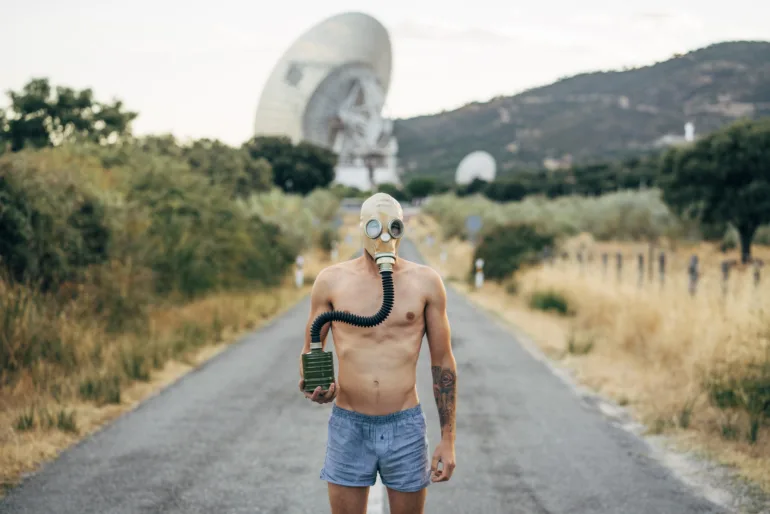Scientists and experts in crisis management advise that we should prepare for different types of disasters. Have you ever thought about what you would do if the 'end of the world' happened? Pandemics, floods, fires or even nuclear war are scenarios that no one wants to experience, but preparing for these possibilities is key to survival. In this article, we will explore which necessities are essential and how best to prepare for different situations.
The UK government recently published emergency preparedness guidelines. Their website lists the basic necessities that every household should have: bottled water, wet wipes and non-perishable food. They recommend having a supply of water (one gallon per person per day) for at least three days and enough non-refrigerated food for the same period.
N95 masks and generators
In the event of a pandemic or scenarios that require smoke protection, it is recommended to have N95 masks as they filter airborne particles better compared to surgical masks or cloth face coverings. Additionally, Robert Handfield, a professor at North Carolina State University, also recommends a gas generator to provide power in the event of outages. Gas generators use an internal combustion engine, so it is necessary to have supplies of natural gas or liquid propane.
Chainsaw and sanitary facilities
If you live in an area with a lot of trees, a chainsaw is indispensable for removing trees that may fall on your house during storms. It is also important to have basic sanitary supplies such as wet wipes, plastic bags and ties for personal hygiene. Do not forget the toilet paper, as it often runs out in crisis situations.

Planning and additional supplies
In addition to basic supplies and tools, it is important to have an emergency plan. The government is advising people to consider the specific needs of their household, including prescription medicines, pet food and extra water. Also prepare flashlights, a hand-wound or battery-powered radio, and extra batteries (Ready.gov).
The importance of being informed
Being informed is key. Download apps that provide real-time information and alerts and learn basic safety skills such as first aid (American Red Cross). The US government and organizations such as Ready.gov and the Red Cross offer detailed supplies lists and plans for various emergency situations. (American Red Cross) (Ready.gov) (American Red Cross).

List of 25 must-have products for the "end of the world" scenario
- Water: One gallon (about 3.8 liters) per person per day, for at least three days (Ready.gov) (American Red Cross).
- Non-perishable food: Canned food, dried fruit, nuts, instant meals that do not require refrigeration (American Red Cross).
- Wet wipes: For personal hygiene and cleaning (American Red Cross).
- N95 masks: To protect against particles in the air, especially in the event of a pandemic or dense smoke (American Red Cross).
- Gas generator: To provide electricity in case of blackouts. Uses natural gas or liquid propane (Ready.gov).
- Chainsaw: For removing trees and other obstacles in the event of storms (Ready.gov).
- Battery flashlight: With extra batteries (Ready.gov).
- Hand-held or battery-operated radio: NOAA weather radio with alert function to receive real-time information (American Red Cross) (American Red Cross).
- First aid kit: Including basic medical supplies and prescription drugs (Ready.gov) (American Red Cross).
- Extra batteries: For all your devices (Ready.gov).
- Whistle: For signaling help (Ready.gov).
- Dust mask: For filtering contaminated air (American Red Cross).
- Plastic films and adhesive tape: For protection against external influences (shelter-in-place). (Ready.gov).
- Tools (wrench, pliers): To turn off utility services, if necessary (Ready.gov).
- Manual can opener: For canned food (American Red Cross) (American Red Cross).
- Local maps: In the event that navigation devices are unavailable (Ready.gov).
- Hand sanitizer and disinfectant wipes: For surface cleaning and personal hygiene (Ready.gov).
- Prescription drugs: Sufficient supplies for several days (American Red Cross).
- Non-prescription drugs: Such as pain relievers, antacids, laxatives, etc. (American Red Cross).
- Glasses or contact lenses and solution: Additional vapors and lens solution (Ready.gov).
- Baby formula, bottles, diapers, wipes and diaper rash cream: Necessities for the youngest ones (American Red Cross).
- Pet food and extra water for them: Supplies for your pets (American Red Cross).
- Toilet paper: Because it often runs out in crisis situations (American Red Cross).
- Blankets and warm clothes: To protect against the cold (American Red Cross).
- Multipurpose knife: For various tasks and as a basic survival tool (American Red Cross).
Conclusion
Preparing for disasters, or rather end of the world – is more than just storing basic necessities. Includes thinking about the specific needs of your family, planning and keeping informed. Get started today and make sure you're prepared for all possible scenarios. Make sure your loved ones are safe and prepared for the future, no matter what it brings.






